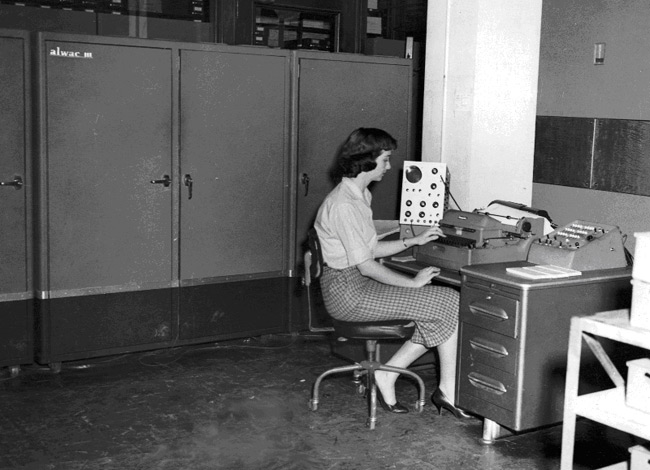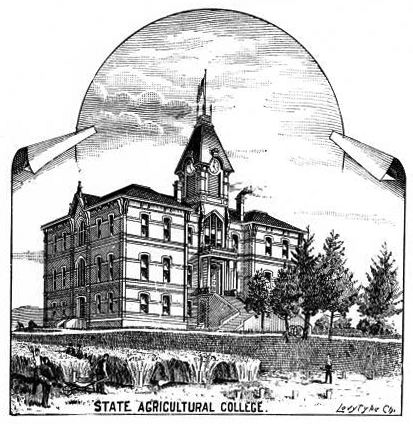|
ALWAC III-E
The ALWAC III-E was an early commercial vacuum-tube computer employing a rotating magnetic drum main storage unit, operational in 1955. It weighed about . The invention of the ALWAC III-E is attributed to Axel Wenner-Gren, and the name is derived from Axel Leonard Wenner-Gren Automatic Computer, letter E stands for the E-register (index register). The ALWAC III-E contained 132–275 vacuum tubes, 5000–5400 silicon diodes, and cost $60,000–$80,000. Word size was 32 bits + sign + recoverable overflow bit. Instruction execution times (including average memory access times) were 5.25–5.75 milliseconds for addition and subtraction, and 21.25 ms for multiplication and division. An ALWAC III-E was installed at the University of British Columbia in March 1957 and remained in service until October 1961. Others were installed at Oregon State University (then College) and Loyola Marymount University (then Loyola University of Los Angeles). An ALWAC III-E was installed by the CIA ... [...More Info...] [...Related Items...] OR: [Wikipedia] [Google] [Baidu] |
Vacuum-tube Computer
A vacuum-tube computer, now termed a first-generation computer, is a computer that uses vacuum tubes for logic circuitry. Although superseded by second-generation transistorized computers, vacuum-tube computers continued to be built into the 1960s. These computers were mostly one-of-a-kind designs. Development The use of cross-coupled vacuum-tube amplifiers to produce a train of pulses was described by Eccles and Jordan in 1918. This circuit became the basis of the flip-flop, a circuit with two states that became the fundamental element of electronic binary digital computers. The Atanasoff–Berry computer, a prototype of which was first demonstrated in 1939, is now credited as the first vacuum-tube computer. However, it was not a general-purpose computer, being able to only solve a system of linear equations, and was also not very reliable. During World War II, special-purpose vacuum-tube digital computers such as Colossus were used to break German machine (teleprinter) c ... [...More Info...] [...Related Items...] OR: [Wikipedia] [Google] [Baidu] |
Magnetic Drum
Drum memory was a magnetic data storage device invented by Gustav Tauschek in 1932 in Austria. Drums were widely used in the 1950s and into the 1960s as computer memory. For many early computers, drum memory formed the main working memory of the computer. It was so common that these computers were often referred to as ''drum machines''. Some drums were also used as secondary storage as for example various IBM drum storage drives. Drums were displaced as primary computer memory by magnetic core memory, which offered a better balance of size, speed, cost, reliability and potential for further improvements. Drums in turn were replaced by hard disk drives for secondary storage, which were both less expensive and offered denser storage. The manufacturing of drums ceased in the 1970s. Technical design A drum memory or drum storage unit contained a large metal cylinder, coated on the outside surface with a ferromagnetic recording material. It could be considered the precur ... [...More Info...] [...Related Items...] OR: [Wikipedia] [Google] [Baidu] |
Main Storage
Computer data storage is a technology consisting of computer components and recording media that are used to retain digital data. It is a core function and fundamental component of computers. The central processing unit (CPU) of a computer is what manipulates data by performing computations. In practice, almost all computers use a storage hierarchy, which puts fast but expensive and small storage options close to the CPU and slower but less expensive and larger options further away. Generally, the fast volatile technologies (which lose data when off power) are referred to as "memory", while slower persistent technologies are referred to as "storage". Even the first computer designs, Charles Babbage's Analytical Engine and Percy Ludgate's Analytical Machine, clearly distinguished between processing and memory (Babbage stored numbers as rotations of gears, while Ludgate stored numbers as displacements of rods in shuttles). This distinction was extended in the Von Neumann arch ... [...More Info...] [...Related Items...] OR: [Wikipedia] [Google] [Baidu] |
Axel Wenner-Gren
Axel Lennart Wenner-Gren (5 June 1881 – 24 November 1961) was a Swedish entrepreneur and one of the wealthiest men in the world during the 1930s. Early life He was born on 5 June 1881 in Uddevalla, a town on the west coast of Sweden. He was the fourth of six children (four girls and two boys) born to Leonard and the much younger Alice Wenner-Gren (née Albin); only three of the children survived to adulthood: Axel, his oldest sister (Anna), and his younger brother (Hugo). His father owned a farm and exported timber to England, which made the family wealthy. Having spent his school years in Uddevalla, Wenner-Gren moved to Gothenburg where he was employed for five years in the spice importing company of a maternal uncle. During this time, he learned English, French, and German at the local Berlitz school, and music at the local YMCA.Luciak, p.14 In 1902, at the age of 21, he left Sweden to further his studies in Germany. He first studied in the university town of Greifswald ... [...More Info...] [...Related Items...] OR: [Wikipedia] [Google] [Baidu] |
Index Register
An index register in a computer's CPU is a processor register (or an assigned memory location) used for pointing to operand addresses during the run of a program. It is useful for stepping through strings and arrays. It can also be used for holding loop iterations and counters. In some architectures it is used for read/writing blocks of memory. Depending on the architecture it maybe a dedicated index register or a general-purpose register. Some instruction sets allow more than one index register to be used; in that case additional instruction fields may specify which index registers to use. Generally, the contents of an index register is added to (in some cases subtracted from) an ''immediate'' address (that can be part of the instruction itself or held in another register) to form the "effective" address of the actual data (operand). Special instructions are typically provided to test the index register and, if the test fails, increments the index register by an immediate con ... [...More Info...] [...Related Items...] OR: [Wikipedia] [Google] [Baidu] |
University Of British Columbia
The University of British Columbia (UBC) is a public university, public research university with campuses near Vancouver and in Kelowna, British Columbia. Established in 1908, it is British Columbia's oldest university. The university ranks among the top three universities in Canada. With an annual research budget of $759million, UBC funds over 8,000 projects a year. The Vancouver campus is situated adjacent to the University Endowment Lands located about west of downtown Vancouver. UBC is home to TRIUMF, Canada's national laboratory for Particle physics, particle and nuclear physics, which houses the world's largest cyclotron. In addition to the Peter Wall Institute for Advanced Studies and Stuart Blusson Quantum Matter Institute, UBC and the Max Planck Society collectively established the first Max Planck Institute in North America, specializing in quantum materials. One of the largest research libraries in Canada, the UBC Library system has over 9.9million volumes among it ... [...More Info...] [...Related Items...] OR: [Wikipedia] [Google] [Baidu] |
Oregon State University
Oregon State University (OSU) is a public land-grant, research university in Corvallis, Oregon. OSU offers more than 200 undergraduate-degree programs along with a variety of graduate and doctoral degrees. It has the 10th largest engineering college in the nation for 2022. Undergraduate enrollment for all colleges combined averages close to 32,000, making it the state's largest university. Out-of-state students make up over one-quarter of undergraduates and an additional 5,500 students are engaged in graduate coursework through the university. Since its founding, over 272,000 students have graduated from OSU. It is classified among "Doctoral Universities – Very high research activity". Chartered as a land-grant university initially, OSU became one of the four inaugural members of the Sea Grant in 1971. It joined the Space Grant and Sun Grant research consortia in 1991 and 2003, respectively, making it the first public university and one of just four in total to attain memb ... [...More Info...] [...Related Items...] OR: [Wikipedia] [Google] [Baidu] |
Loyola Marymount University
Loyola Marymount University (LMU) is a private Jesuit and Marymount research university in Los Angeles, California. It is located on the west side of the city near Playa Vista. LMU is the parent school to Loyola Law School, which is located in downtown Los Angeles. LMU offers 55 major and 59 minor undergraduate degrees and programs across six undergraduate colleges. The Graduate Division offers 47 master's degree programs, one education doctorate, one doctorate in juridical science, a Juris Doctor and 13 credential programs. LMU's sports teams are called the Lions and compete at the NCAA Division I level as members of the West Coast Conference in 20 sports. History Loyola Marymount University is the product of a merger between Loyola College, founded in 1917, and Marymount College, founded in 1932, with its roots in Marymount School which was founded in 1923. St. Vincent's College The present university is the product of the first institution of higher learning in Southe ... [...More Info...] [...Related Items...] OR: [Wikipedia] [Google] [Baidu] |
University Of Turku
sv, Åbo universitet , latin_name = Universitas Aboensis , image_name = University of Turku.svg , motto = ''Vapaan kansan lahja vapaalle tieteelle'' , established = 1920 , type = Public University , endowment = , administrative_staff = 3,412 , rector = Jukka Kola , students = 20,768 , undergrad = 8,247 , postgrad = 6,244 , doctoral = 1,984 , city = Turku , country = Finland , campus = Urban , free_label = , free = , colors = , colours = , mascot = , affiliations = Coimbra Group, UArctic , website Official Website (in English) , motto_lang = fin , mottoeng = The gift of a free nation to free science ... [...More Info...] [...Related Items...] OR: [Wikipedia] [Google] [Baidu] |
Turku
Turku ( ; ; sv, Åbo, ) is a city and former capital on the southwest coast of Finland at the mouth of the Aura River, in the region of Finland Proper (''Varsinais-Suomi'') and the former Turku and Pori Province (''Turun ja Porin lääni''; 1634–1997). The region was originally called Suomi (Finland), which later became the name for the whole country. As of 31 March 2021, the population of Turku was 194,244 making it the sixth largest city in Finland after Helsinki, Espoo, Tampere, Vantaa and Oulu. There were 281,108 inhabitants living in the Turku Central Locality, ranking it as the third largest urban area in Finland after the Capital Region area and Tampere Central Locality. The city is officially bilingual as percent of its population identify Swedish as a mother-tongue. It is unknown when Turku gained city rights. The Pope Gregory IX first mentioned the town ''Aboa'' in his ''Bulla'' in 1229 and the year is now used as the foundation year of Turku. Turku ... [...More Info...] [...Related Items...] OR: [Wikipedia] [Google] [Baidu] |
Vacuum Tube Computers
Vacuum-tube computers, now called first-generation computers, are programmable digital computers using vacuum-tube logic circuitry. They were preceded by systems using electromechanical relays and followed by systems built from discrete transistors. Some later computers on the list had both vacuum tubes and transistors. This list of vacuum-tube computers is sorted by date put into service: }) are identical, except input-output equipment. Both were used internally. , - , The Wegematic 1000 , , 1960 , , , Improved version of the ALWAC III-E , - , ZRA 1 , , 1960 , , , Built by VEB Carl Zeiss, Jena, German Democratic RepublicSiegmar Gerber: ''Einsatz von Zeiss-Rechnern für Forschung, Lehre und Dienstleistung in Informatik in der DDR – eine Bilanz''. GI-Edition, Bonn 2006, p. 310–318 , - , Minsk-1 , , 1960 , , , Built in Minsk , - , Odra 1001 , , 1960 , , , First computer built by Elwro, Wroclaw, Poland , - , Minsk-1 , , 1960 , , , Built in Minsk , - ... [...More Info...] [...Related Items...] OR: [Wikipedia] [Google] [Baidu] |





.gif)



.jpg)